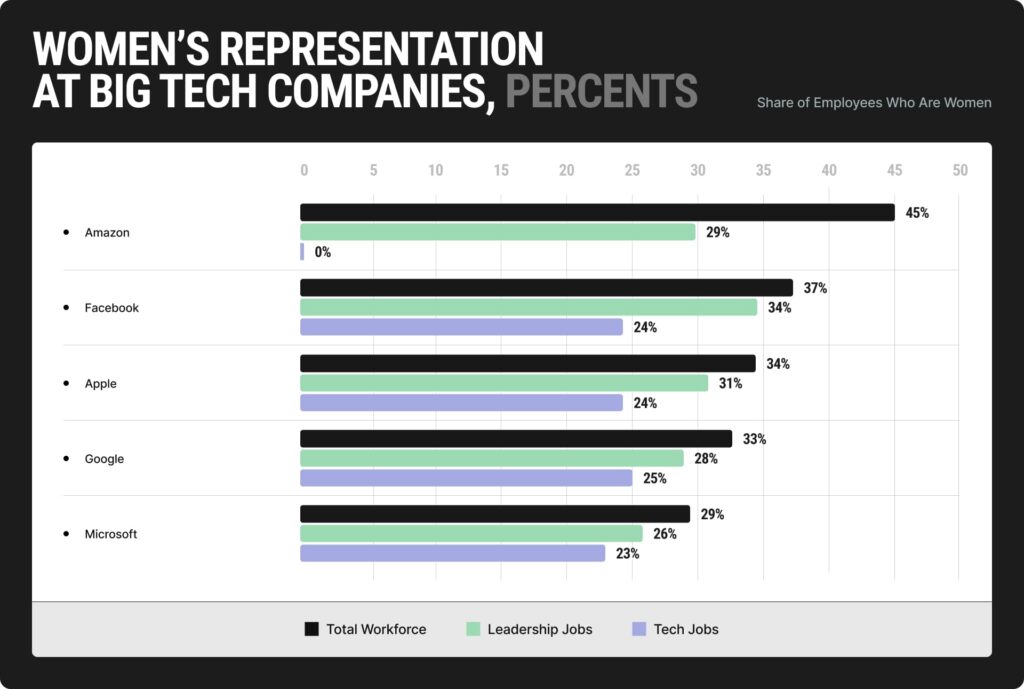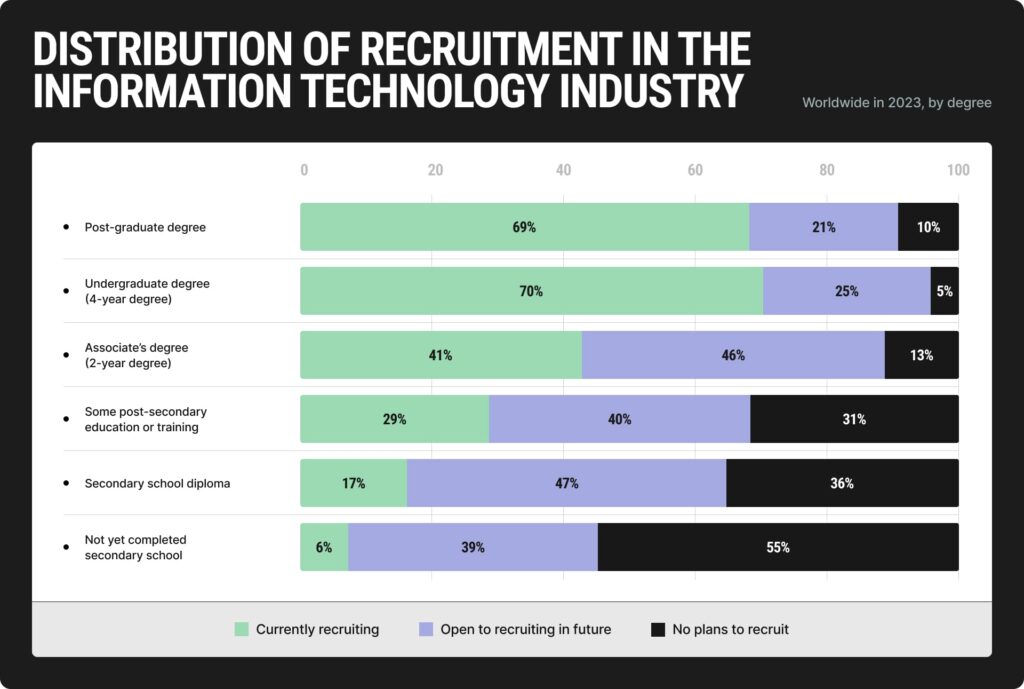Gone are the days when you couldn’t get a job because of disability, race, or sexual orientation. Nowadays, DEI (Diversity, Equality, and Inclusion) is an essential part of the software company policy, which truly makes us happy as companies appreciate and value your expertise and soft skills without judging you for your identity.
Diversity takes numerous forms; it’s not only about gender but also about age, culture, educational background, and the list goes on. Many companies embrace DEI. For instance, at Kitrum, DEI is central to our values. We celebrate our team members’ uniqueness, creating an inclusive environment where everyone’s voice matters. Our commitment to DEI goes beyond our team – we strive to develop solutions that empower diverse businesses and communities worldwide. As you may see, the topic is really hot.
Let’s talk today about the current state of diversity in software development, why you need to implement DEI in your organization, and we’ll give you 3 tips on how to start promoting DEI already tomorrow. Let’s begin!
Diversity in software development today
Gender diversity
Speaking of gender diversity within the tech sector, some advancements have already been achieved by far, though they have not been uniform or equally distributed across all aspects of the industry yet.
Despite the fact that women hold 44% of STEM-related bachelor’s degrees as of 2022, indicating significant educational achievement, the reality remains stark in the software development industry. Women still remain underrepresented in the tech industry.
According to Zippia, in the US, where women constitute 47% of all employed adults, they hold only 28% of computing and mathematical roles, and only 15% of engineers are women, pointing to a persistent gender gap in employment.

Thus, at major tech giants like Apple, Facebook, Google, and Microsoft, there’s a notable disparity between the % of female employees overall and the representation of women in technical roles. For instance, while Apple’s workforce is 34% female, only 24% of its technical jobs are held by women. Similar trends are observed at Facebook (37% female workforce, 24% in technical roles), Google (33% female workforce, 25% in technical roles), and Microsoft (29% female workforce, 23% in technical roles).
However, at KITRUM, women make up 42% of the workforce compared to 58% of men, indicating a more balanced gender representation, which reflects the company’s commitment to diversity and inclusion efforts.
Even within the largest tech companies in the US, where women make up 34.4% of the workforce, the representation at the leadership level remains low, with only 18% holding CIO and CTO roles.
Educational background
However, in terms of educational background within the IT industry, women are making significant strides. As of 2022, women hold 44% of STEM-related bachelor’s degrees, reflecting their increasing participation in higher education.
Moreover, data shows that women outnumber men in obtaining each educational tier from high school to master’s degree, indicating a trend towards greater educational attainment among women.

Also, in 2023, Statista revealed that 70% of global business leaders in the IT industry prefer undergraduate candidates, emphasizing the importance of a four-year degree in the hiring process. In contrast, only 41% of respondents prioritize candidates with an associate degree, highlighting the value placed on higher levels of education within the industry. However, statistics clearly demonstrate the crucial significance of education within IT companies.
Racial diversity
Various statistics highlight significant disparities in racial diversity within the tech sector. For example, in the United States, only 14% of Latinx individuals hold computer and mathematical occupations, while Black Americans represent just 7% in these fields. Similarly, immigrants account for only 25% of tech workers in Canada.
According to Zippo, white Americans make up 62.5% of the workforce in the US tech sector, followed by Asian Americans at 20%, Latinx Americans at 8%, and Black Americans at 7%. Again, mainly white individuals hold leadership roles, with 83.3% of tech executives in the US being white.
Yet, Apple is a great example of a company that widely embraces DEI. Apple’s 2022 diversity report indicates progress with 29.8% Asian, 9.2% Black, and 14.9% Hispanic/Latinx representation in its workforce. Notably, gender diversity at Apple has seen a modest increase, with female representation rising from 30% in 2014 to 35% in 2022.
Why does your company need a diverse team?
Not only is the topic of diversity very popular nowadays, but diversity in software development teams offers numerous benefits that contribute to creating innovative and successful products, promote creativity and innovation, and lead to more inclusive, user-friendly, and competitive products in the global marketplace.
Moreover, in a recent study, 60% of participants surveyed on LinkedIn highlighted that the presence of diverse teams significantly contributed to the success of their respective teams. Here are some key advantages of diverse teams:
- Improved problem-solving: Different viewpoints and approaches to problem-solving improve the team’s ability to address complex challenges. Let’s agree that diversity fosters creativity and encourages out-of-the-box thinking, allowing teams to approach problems from multiple angles and develop more innovative solutions.
- Better productivity: Embracing diversity and fostering an inclusive team environment has significantly improved productivity, leading to more innovative solutions and better overall performance. According to statistics, teams that embrace inclusivity are usually 35% more productive.
- Improved product design: Diversity in software development teams can result in products that better meet the needs of a diverse user base. By incorporating perspectives from individuals with different cultural backgrounds, abilities, and preferences, teams can create more inclusive and user-friendly products that resonate with a broader range of users.
- Diverse companies thrive: A recent report reveals that companies embracing diversity experience a significant boost in financial performance, with those fostering inclusivity earning 2.5 times higher cash flow per employee compared to their less diverse counterparts.
- Improved decision-making: According to the research, 87% of the time, diverse teams make better decisions – and this is a fact. Such teams are better equipped to make well-rounded and informed decisions. By considering multiple perspectives and challenging assumptions, teams can arrive at more robust and thoughtful choices that consider various factors and potential outcomes.
- Streamlined hiring process: Embracing diversity not only enhances a company’s performance but also streamlines the team-building process, as it opens doors to a wider pool of talent with varied perspectives and skill sets. Companies prioritizing diversity foster an inclusive environment where individuals from different backgrounds feel valued, leading to greater creativity, innovation, and, ultimately, team cohesion.
- Increases happiness rate: At Kitrum, we believe that diversity enhances workplace happiness and satisfaction. With 96% of our members proudly embracing their roles at Kitrum, we celebrate each individual’s uniqueness.
How to promote diversity? Top 3 tips from Kitrum
Not only do big companies embrace diversity more and more, considering all the benefits above, but small and middle-size companies also stream to embrace DEI. In 2023, 154 out of the Fortune 500 companies have voluntarily published reports regarding diversity, equity, and inclusion initiatives. So, how do you promote DEI in your company?
Create an inclusive job description
Start by creating inclusive job descriptions to attract diverse talent and foster a more inclusive workplace. Inclusive job descriptions use language that welcomes candidates from various backgrounds, avoiding biased or exclusionary terms. They focus on essential job requirements and qualifications while emphasizing the company’s commitment to diversity and inclusion. By crafting inclusive job descriptions, organizations can attract a broader pool of qualified candidates, leading to a more diverse and innovative workforce.
Take a look at HubSpot’s job description. This job description literally says, “Don’t worry if you’re not feeling very confident – we still want you to apply!” and it does encourage a lot. It also tells people with disabilities that they can ask for help during the interview process. This shows that the company cares about including everyone, no matter how they’re feeling or what challenges they may have. The company wants to ensure everyone has a fair chance to apply and be considered for the job, no matter who they are.
Implement a blind recruitment process
Continue with the implementation of blind recruitment. It involves removing identifying information such as names, gender, age, education, and ethnicity from resumes to ensure fair consideration for diverse candidates. Structured interviews with standardized questions and diverse interview panels further mitigate biases. Using blind assessment tools and providing training on diversity awareness help ensure a more equitable recruitment process.
For example, a long time ago, Google’s Head of People Operations, Laszlo Bock, revealed that Google doesn’t prioritize degrees from prestigious universities like Harvard or Stanford. Instead, they focus on hiring problem solvers, leaders who are willing to empower others, and individuals who embody “Googleyness,” their cultural fit. Bock emphasizes intellectual humility and a commitment to diversity and problem-solving over specific qualifications or grades. Google’s hiring strategy values adaptability and a proactive approach to challenges rather than academic pedigree or traditional interview tactics like brainteasers.
Have DEI workshops
Immerse your teams in diversity training and workshops to cultivate cross-cultural collaboration and knowledge sharing. Encourage active participation and open dialogue to foster mutual understanding and respect among team members from diverse backgrounds. Equip your workforce with the tools and skills to navigate cultural differences effectively, fostering stronger relationships and enhancing team performance.
For instance, Salesforce exemplifies inclusive learning programs that drive diversity and equality within the workplace. Through its Training Provider Program, Salesforce partners with organizations globally to deliver expert-led classes, empowering individuals from diverse backgrounds to gain essential skills for placement within the Salesforce ecosystem. By fostering a culture of inclusion and equality, Salesforce not only attracts top talent but also improves workplace diversity, which in turn fuels innovation and increases profitability.







